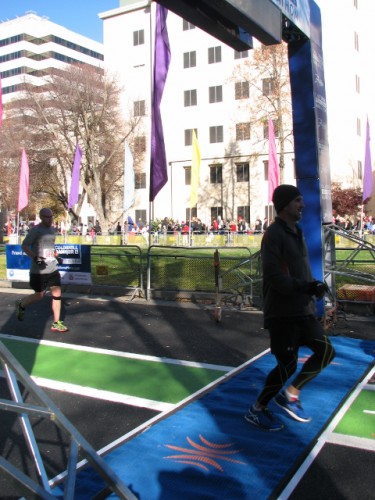The last day of our California trip came too soon. It was Tuesday, and Jon was still a bit sore from running the marathon on Sunday, so we had another relaxing day. We stopped by Total Wine to pick out some wines to bring home, and did a little shopping. Then we headed out to the Maidu Indian Museum in Roseville, CA.
The Maidu Indian Museum is a small museum and interpretive center that is located on the site of an ancient village where the Maidu people lived for over 3,000 years. The area saw the first signs of human habitation around 9,000 years ago – and historians believe that the Maiduan dialect began breaking off from other Native American languages around 2,000 years ago.
Around the same time, inhabitants began settling down in the area and managing the land through the use of burning, pruning, and gathering selected plants. Acorns were plentiful there, and they provided a nutritious staple for their diet. The Maidu also fished, hunted and gathered plants and berries. They had an extensive knowledge of the medicinal uses of the plants in the area, and actively treated the sick and injured with various remedies.
The Maidu are expert basket weavers, using the reeds and grasses to weave baskets that range in size from a thimble to several feet across. The museum has several excellent examples of Maidu woven baskets, and ceremonial pieces, including tools and regalia. There is also a photo exhibit of historical photographs of the tribe.
The museum contains exhibits detailing the history of the Maidu habitation of the site, from prior to the arrival of the settlers through the period when the Native Americans were displaced from the area after gold was discovered in the area. Exhibits talk about the Maidu trail of tears, the forced relocation to undesirable land. It was hard to read about the hardships of their new home, and the destruction of their way of life.
After checking out the museum, Jon and I stepped outside to take a walk on the interpretive trail. The trail is a short loop around the property, with signs at several locations explaining how life took place there. One of the most abundant examples of the history of habitation there are the bedrock mortar holes, where women used sticks to grind acorns for thousands of years. Over time, the constant use of the holes wore deep depressions into the bedrock.
The site also contains petroglyphs, but these aren’t as apparent. They give you a little map to help find them, but Jon and I only saw one that we were sure was a petroglyph. The others seemed like they could be natural; there were long scratches on some of the rocks that looked like the marks that are left behind by glaciers as they move other huge rocks along with them.
This site was placed on the National Register of Historic Places in 1973, so it will be preserved for future generations to understand all aspects of the area’s history. It was a pleasant visit; not an amazing museum by any means, but worth a few hours of our time. If you are in Roseville and find yourself with a few extra hours, stop in and see for yourself.





































